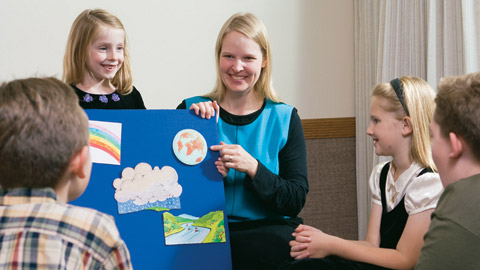
“Church-produced lesson manuals are carefully prepared to ensure that the doctrines of the Church are kept pure. They establish guidelines for teaching in Church settings, and they ensure a consistent approach to gospel topics and principles. You should be true to the teachings and guidelines in these manuals. However … you may adapt the lessons according to the needs and circumstances of those you teach” (Teaching, No Greater Call [1999], 102; italics added).
Lesson materials provided by the Church are an essential resource in teaching all students. Adapting those lesson materials can help you more effectively teach individual students. As a teacher, you can make adaptations in many different areas:
- Change the amount of help given to a student.
Example: Allow a peer to sit next to a student to help the student read.
- Simplify classroom materials.
Example: Focus on a key phrase or a few key words in the scriptures instead of a block of verses.
- Use a different method of communication.
Examples: Sing a song that helps with the lesson, or use pictures to demonstrate an idea.
- Adjust the difficulty of a task.
Example: Ask questions that everyone in your class could answer.
While it is important to understand the limitations that a student may have, it is more helpful to focus on the student’s abilities. Often, when you adapt lesson materials for one student, many other students benefit as well.
It is important to have a clear objective as you prepare your classroom activities. Identify the principles that will be most helpful for the students.
Other considerations as you adapt your lesson:
- Find ways for everyone to participate in classroom activities.
Example: Ask a member with a disability to serve in a class presidency or to hand out papers.
- Use visual resources such as pictures, videos, and objects that can help students understand difficult concepts.
Example: Use the Primary Symbols, Gospel Art Book or pictures from Church magazines.
- Help students connect new ideas to things that they already understand.
Example: If a student has an interest in sports, use a sports analogy to explain a principle.
- Prepare a student before class to help him or her participate successfully in the lesson.
Example: Provide an outline of the class or give someone a scripture to read ahead of time.
- Try to make adaptations without unnecessarily singling out a specific student in front of his peers.
Example: Invite each person in the class to choose whether to discuss a chapter out loud or by writing thoughts down on paper.
Book of Mormon Stories is a good example of a helpful adaptation for a student who is a visual learner or for someone with basic reading skills. Many Church materials are also available in alternative formats such as audio, large print, Braille, and American Sign Language.
The Lord speaks to us “unto [our] understanding” (2 Nephi 31:3) and gives us knowledge “line upon line, precept upon precept, here a little and there a little” (2 Nephi 28:30). As you make efforts to teach the gospel in a way that each of your students will understand, their testimonies will be strengthened.
Additionally, there are teaching tips listed under each of the disability categories on this website.
